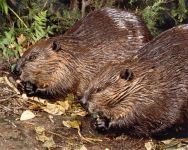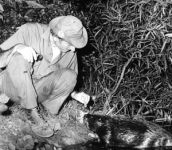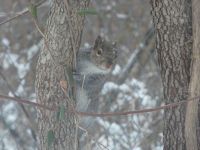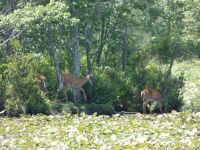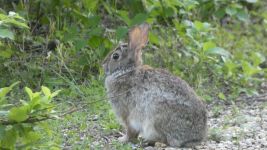Beaver Tales from Unexpected Wildlife Refuge, October 2020
Beaver & Cavit Buyukmihci
We hope that you and your loved ones remain safe and well during this continuing pandemic. Since our last newsletter, the Refuge has continued to provide an opportunity for people to visit and explore, enjoy the fresh air and observe abundant wildlife in a natural setting. We welcome visitors and look forward to sharing our very special safe haven for wildlife with you.
Running a wildlife Refuge is not only physically and emotionally demanding, there are always expenses with which to deal. Although we are frugal in how we spend Refuge funds – having only one employee and an all-volunteer Council of Trustees – we need your help in ensuring the continuation and longevity of the Refuge. We hope you will take the time to make the most generous donation you can...now . And, know that we – and the wildlife – are grateful for your continued support.
Contents of this month's newsletter:
News items
Riders pose for photo
Volunteers hand out refreshments
Refuge co-hosted TnT Cycling fundraising event
Brigitte and Jared
Former Eagle Scout returns to Refuge
volunteered at the Refuge with his troop in the summer of 2011. He and the other troop members installed our beaver viewing platform (seen in lower right of photo), at the main pond near Headquarters, which remains a very popular spot for our visitors. After meeting with Jen, Jared and Brigitte enjoyed the views of the main pond from the platform and hiked the trails.
Imprisoned bear
Refuge becomes part of campaign to end wildlife trade
Coalition of non-human animal and environmental organizations calling on The White House to support a permanent ban on wild animal markets that could become sources for future pandemics and to commit to ending international trade in wild animals and their products. The Coalition, which is led by World Animal Protection and represents more than 10 million supporters across the US, has sent a letter urging the US Government to support this issue at the upcoming G20 Leaders' Summit taking place in November 2020.
Beavers in the news
Here are some recent news media articles concerning beavers. You can see our entire and growing list, a tribute to this wonderful keystone species, in our Beavers in the News page . If you come across a news item on beavers, please send us the link so that we can consider it for inclusion.
Beavers: Why give a dam | Ranger Ramblings , by Sam Richards.
Sam Richards on beaver dam
Flooding from beaver dams creates new wetlands upstream, and while they may not be the most visually stunning environments, there is more to these wet spots than meets the eye. Benefits of wetlands include providing critical habitat to an abundance of plants and animals, water storage, carbon fixation, stream bank reinforcement, enhanced nutrient cycling and flood protection.
The Trials and Tribulations of Beavers in Scotland: A Species of the Times , by Coreen Grant
After protected status was achieved in 2019, Pike stated that the reintroduction of beavers was about 'restoring the balance of nature that we have thrown so badly off-course – and reappraising how we live alongside species other than ourselves.' It seems that now, in light of the report, a new reappraisal is needed if we are to retain beavers as a prospering part of our natural environment. In a wider perspective of climate emergency, in which the effects of a chronic decline in biodiversity are becoming increasingly apparent, the precarious future of beavers in Scotland highlights larger questions about our priorities going forward.
Beavers will make the River Otter a forever home after successful completion of trial
Beaver carrying food branch
'This work, carried out under a licence issued by Natural England, has confirmed the positive transformations that these animals can create, including the benefits they provide for many other species, such as fish, improving water quality and smoothing flood peaks.
Rare beaver rescued in Xinjiang
On the afternoon of August 17, villagers found an injured beaver near the Bulgan River in Qinghe County, northwest China's Xinjiang Uygur Autonomous Region. ... The beaver is a subspecies of Eurasian beaver, named Castor fiber birulai. As the only beaver species living in China, it is extremely rare and is under first-class national protection.
Campaigns for wildlife in New Jersey
American black bears
Keep saying NO to bear hunting in New Jersey starting next 'season' and prioritize non-lethal management strategies has no guarantee of being approved . In the meantime, the ongoing maiming and slaughter of these sentient and majestic animals with bows and arrows, rifles and shotguns, continues.
executive order :
Three petitions you should sign if you have not done so already:
Bobcat; Jean Beaufort
Wildlife killing contests continue in New Jersey
White-tailed deer safe at Refuge
Continued persecution of deer in New Jersey Deer
Deer Resources & Information
Non-Hunting License
Snapshots of life at the Refuge
Beavers via trail camera
Beavers via trail camera
Beavers passing by trail camera
Female American goldfinch
Female American goldfinch
American goldfinch seeks food near Headquarters
Male eastern tiger swallowtail
Male eastern tiger swallowtail
Eastern tiger swallowtail puddles near Headquarters
Female groundhog
Female groundhog
Aboveground groundhog adventures
American bullfrog
American bullfrog
American bullfrogs along the main pond dike
Great blue heron (and turtles)
Great blue heron
Great blue heron views main pond domain
American grass spider
American grass spider in her tunnel web
Canada goose family
Canada goose family
Canada goose family in a trail camera venue
Raccoon
Raccoon
Raccoon 'fishing' after midnight
Northern red-bellied turtle
Northern red-bellied turtle
Red-bellied turtle in search of nesting site
A glimpse at our past
Otter, via trail camera in 2017
Son of Refuge co-founders reminisces about otters at the Refuge I used to explore much of the habitat hoping to get a glimpse of the numerous species of animals who lived there. As an amateur herpetologist, I concentrated on snakes and other reptiles. But, I was always equally (almost) thrilled to see the various mammals, too. One of the elusive ones was the American river otter. I would occasionally get a glimpse of one or more swimming in the main stream that runs through the main pond, but never got to see them up close.
Take action to help wildlife at the Refuge
Beaver kits
Reminder about helping us help wildlife today We depend entirely on the support of our donors for our day-to-day expenses! We know that you have limited resources and need to consider which of numerous worthwhile causes to support. We hope, however, that you can again find it possible to give us a donation – today – of any amount. We and the wildlife need your support now .
Canada goose family
Helping wildlife and the Refuge in the future and wildlife . When talking with your estate planner, just provide them with our name, address and tax identification number (23-7025010 ). This is one of the most important gifts the Refuge can receive. If you have already included us in your future plans, please let us know – and thank you!
Take action to help wildlife everywhere
Here are a few of the current issues where wildlife, whether living freely or imprisoned in circuses, zoos or other venues, can benefit from your help. We urge you to take action and share with others.
Red-eyed treefrog, Care2
Urge United Nations to address alarming loss of tropical animals
decrease in animal populations in the tropical Americas:
A new report just revealed that human action has killed over half the world's wildlife in just 50 years
Long-tailed macaque
Ask the Mauritius government to refuse a permit to capture wild monkeys and expand a primate breeding farm
7,500 captive individuals, but also to allow it to trap wild monkeys as well, something increasingly being prohibited by other countries.
Urge Mauritius government to refuse permission for capture of wild monkeys and expansion of primate breeding farm for vivisection
Owl, Care2
Environmental Protection Agency should ban pesticides
neonicotinoids , a category of highly toxic pesticides that are applied to a crop's seed instead of the plant, thereby exposing birds to the deadly toxins: Owls, sparrows, and many more birds could go totally extinct thanks to Trump's irresponsible policies
Contact us
Unexpected Wildlife Refuge
http://unexpectedwildliferefuge.org/
info@unexpectedwildliferefuge.org
